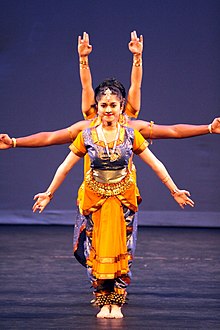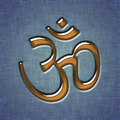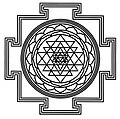Hindu iconography

Over the millennia of its development Hinduism has adopted several iconic symbols, forming part of Hindu iconography, that are imbued with spiritual meaning based on either the scriptures or cultural traditions. The exact significance accorded to any of the icons varies with region, period and denomination of the followers. Over time some of the symbols, for instance the Swastika has come to have wider association while others like Aum are recognized as unique representations of Hinduism. Other aspects of Hindu iconography are covered by the terms murti, for icons and mudra for gestures and positions of the hands and body.
Contents
Hindu Sacraments[edit]
Hindu sacraments are physical objects or markings that are considered sacred and used as a sign of devotion by the followers of Sanathana dharma (Hinduism). These are often objects associated with a puja (prayer) or religious ceremony.

Tilaka[edit]
The tilaka (or tilak) is a mark worn on the forehead or other parts of the body as a sign of spiritual devotion. Hindus may wear a tilaka regularly or especially on religious occasions. The shape of the tilaka is often an indicator of devotion to a certain deity. For example, a 'U' shape tilaka usually denotes devotion to Vishnu, while Shiva devotees often wear it in the form of three horizontal lines. It may be made of saffron, vermilion, turmeric, clay or simply ash.
To denote marriage and auspiciousness, married Hindu women commonly wear a decorative vermilion dot or bindu, or bindī on the forehead. This is analogous to a wedding ring worn in western countries. In southern India, the mark is called pottu (or bottu). The exact shape, size and location of the bindi or pottu shows regional variation; for instance, in northern India the bindi is often worn just below the hairline, while in southern India it is more common to wear it between the eyebrows. In east India, especially in West Bengal, traditionally larger bindis are worn as mark of devotion towards Goddess Durga.
Vibhuti[edit]
Vibhuti is the holy ash obtained from sacred puja rites involving fire. Also a variant called Basma used as Vibhuti is prepared from the purified ashes of cow dung. Ash as the product of fire is considered intrinsically pure[citation needed]. It is used on the forehead, normally as three horizontal lines representing Shiva. Some Hindus meld both the three horizontal vibhuti lines of Shiva and the 'U' shape thilaka of Vishnu in an amalgam marker signifying Hari-Hara (Vishnu-Shiva). In addition, sacred ash signifies that the body's origin is from dust and ash and to dust and ash it shall return. The ash is a marker of impermanence. Everything in the interim is but an illusion (maya).
Vibhuti, when applied to the forehead, also symbolizes the willingness to destroy negative thoughts and qualities (jealousy, envy, anger, greed, etc.), as these negative qualities, if not destroyed, will bring all kinds of pains in life.
Rudraksha[edit]
Rudraksha are seeds of the rudraksha tree that, in Hinduism, represent the tears of Lord Shiva (also known as, Rudra). They are often threaded into a necklace and used as a rosary to accompany prayer and meditation.
Universal symbols[edit]
Among the most revered symbols in Hinduism, three are a quintessential part of its culture, and are most representative of its general ethos:
Om (pronounced Aum)[edit]
Om (or Aum, ॐ) is the sacred sound symbol that represents Universe; the ultimate reality (Brahman). It is prefixed and sometimes suffixed to all Vedic mantras and prayers. Aum is often said to represent God in the three aspects of Brahman (A), Vishnu (U) and Shiva (M). As the Divine primordial vibration, it represents the one ultimate reality, underlying and encompassing all of nature and all of existence. The written syllable ॐ called omkara serves as a deeply significant and distinctly recognizable symbol for Hindu dharma. The pronunciation of Aum moves through all possible human linguistic vowel sounds and is different from the pronunciation of Om. Both are often symbolically equated, although they are sonically distinct.
Swastika[edit]
Swastika is a symbol connoting general auspiciousness. It may represent purity of soul, truth, and stability or, alternatively, Surya, the sun.[1] Its rotation in four directions has been used to represent many ideas, but primarily describes the four directions, the four Vedas and their harmonious whole. Its use in Hinduism dates back to ancient times.
Sri Chakra Yantra[edit]
Sri Chakra Yantra of Tripura Sundari (commonly referred to as Sri Yantra) is a mandala formed by nine interlocking triangles. Four of these triangles are oriented upright, representing Shiva or the Masculine. Five of these triangles are inverted triangles representing Shakti, or the Feminine. Together, the nine triangles form a web symbolic of the entire cosmos, a womb symbolic of creation, and together express Advaita Vedanta or non-duality. All other yantras are derivatives of this supreme yantra.
Symbols associated with individual deities[edit]

Several symbols (animals, flora, instruments, weapons, or even color) in Hindu iconography are associated with particular devas, and vice versa. In certain cases the deities themselves are personifications of natural forces, for instance Agni (fire), Vayu (wind), Surya (Sun) and Prithvi (Earth). In other instances, the associations arise from specific incidents or characteristics related in Hindu theology. The iconography serve to identify the particular deity in their pictorial or sculptural representations. The symbolism also often links the deities with a particular natural or human attribute, or profession.
It is important to understand the symbolism, in order to appreciate the allegorical references in not only Hindu scriptures (for instance, Puranic tales), but also in both ancient and modern secular works of authors from the Indian subcontinent. The art and science of designing temples includes the study of sculpture and the ornamentation of religious significance as described in sacred texts (shilpa shaastra aagamas). In Ancient India twelve years of theoretical and practical training used to be given to the student by an able experienced teacher.
Shiva Lingam[edit]
The Shiva Lingam represents the divine being Shiva, and is used as a symbol of the power of fertility and strength[citation needed]. Shivalinga (Sivalinga) is the most important and a popular symbolic representation of Lord Shiva (Siva) in Hinduism. It represents God Himself in His all the three aspects – Creator, Sustainer or Protector and Destroyer (Dissolutor).[2]
Meaning[edit]
The word ‘Shivalinga’ is a combination of the words ‘Shiva’ (auspiciousness) and linga (sign or symbol). Thus ‘Shivalinga’ is a representation of God in His all-auspicious aspect. Again ‘Shiva’ also means ‘One in Whom all creation sleeps after dissolution’. ‘Linga’ also means the place of dissolution of the disintegrated universe.[2] The Shiva linga represents the supreme creator, the cause behind the creation, protection, and destruction of everything visible and invisible and the god shiva.
TYPES[edit]
Based on the mobility of the object of worship, Shivalingas are broadly divided into two categories – ‘Cala’ and ‘Acala’[3]
Cala Shivalingas[edit]
These are made of stone, crystal, metals, clay, rice, dough, etc. These can be moved from one place to another.[3]
Acala Shivalingas[edit]
The sacred texts describe many types of shiva linga based on variations in the proportions. The following is the description of sarvatobhadra shiva lingam preferably constructed in black spotless hard stone which can be worshiped by every living being. These Shivlingas are installed in temples and are fixed to ground or a base. They are usually made of stones or metals. The sacred texts suggest that the shiva linga must have three parts. A bottom most 1/3rd part that is in the earth - Brahma bhaagam (represents Brahma, the Creator of the World) it is rectangular in cross section.[3] A middle 1/3rd part is called Vishnu Bhaagam or Vishnu Bhaga (it represents Vishnu, the Protector and sustainer of the world ); it is octagonal in cross section. Both the Brahma bhaagam and Vishnu Bhaagam are embedded in peetham (the ornamental pedestal).[4] A visible 1/3rd Shiva Pooja bhaagam or Pooja bhaga( also known as Rudra bhaagam or Rudra bhaga) which is top most part which is worshiped. It is circular in cross section and cylindrical in shape. It represents Rudra (Shiva), the Dissoluter or Destroyer of the World. It is known as Pooja bhaagam because this part is worshipped.[4] Brahmasutras: These are certain essential lines present on the Rudra bhaagam (Rudra bhaga). Without them a Shivlinga is unfit to be worshipped.[4] The Shiva linga is at the level of ground and easily accessible to the worshipers irrespective of their caste, social or economic status.
The Lotus[edit]
The Lotus is associated with the creation theology as well as the gods Vishnu, Brahma, and Lakshmi. It is the symbol of beauty and fertility. "In the Bhagavad Gita, a human is adjured to be like the lotus; they should work without attachment, dedicating their actions to God, untouched by sin like water on a lotus leaf, like a beautiful flower standing high above the mud and water." [5]
The Veena[edit]
The musical instrument Veena is associated with the Hindu goddess Saraswati and the sage Narada. It represents arts and learning.
Conch[edit]

The conch shell is a major Hindu article of prayer, used as a trumpeting announcement of all sorts. The God of Preservation, Vishnu, is said to hold a special conch, Panchajanya, that represents life as it has come out of life-giving waters. In the story of Dhruva the divine conch plays a special part. The warriors of ancient India would blow conch shells to announce battle, such as is famously represented in the beginning of the war of Kurukshetra in the Mahabharata, a famous Hindu epic. The conch shell is also a deep part of Hindu symbolic and religious tradition. Today most Hindus use the conch as a part of their religious practices, blowing it during worship at specific points, accompanied by ceremonial bells. Shankha also symbolizes the sound that created the universe and stands for knowledge.
Chakra[edit]
The Chakra or disc-like weapon of Vishnu is often found mounted on the top of Vaishnava temples or incorporated into architectural designs. Images depicting Vishnu's four-armed Narayana form almost always include the Chakra in one of his hands. It is a general symbol for protection. Chakra is also known to symbolize the need to follow dharma and to condemn adharma.
Multiple heads and arms[edit]

This section needs expansion. You can help by adding to it. (July 2011) |
An array of Hindu, Buddhist, and some Jain deities are often depicted with multiple heads, arms, and other body parts, creating what one author refers to as a "multiplicity convention" in religious iconography.[6] Such multiple body parts represent the divine omnipresence and immanence (ability to be in many places at once and simultaneously exist in all places at once), and thereby the ability to influence many things at once.[6] The specific meanings attributed to the multiple body parts of an image are symbolic, not literal in context.[7] In such depictions, the visual effect of an array of multiple arms is to create a kinetic energy showing that ability.[8]
Vāhana[edit]
Vāhana or vehicle, sometimes called a mount, is an animal or mythical entity closely associated with a particular deity in Hindu theology. Sometimes the deity is iconographically depicted riding and/or mounted on the vahana; other times, the vahana is depicted at the deity's side or symbolically represented as a divine attribute.
Vishnu[edit]
Vishnu is the Protector-God. Of the three gods of the Hindu Triad, Vishnu, being the Preserver, appears most human. The Rig Vedic Vishnu is conceived as the sun in three stages - rising, zenith and setting. The Vedic Vishnu strides through the heavens in three steps. This is Vishnu's great deed and constitutes his great glory. With these three steps Vishnu, a solar deity, courses through the three divisions of the universe, "the god being manifest in a threefold form, as Agni on earth, Indra or Vayu in the atmosphere and Surya in the sky". He is said to have taken these three steps for the preservation and benefit of mortals. The zenith is appropriately called Vishnu's place. His third step cannot be seen with human eyes. It is here that Indra dwells.
Table of symbols[edit]
| God or deity | Associated symbols | Note |
|---|---|---|
| Adi parashakti | Chariot of seven lions, Sri Chakra | Supreme Deity of Hindu mythology |
| Brahma | Lotus, swan (hamsa), Vedas, garland of beads (akshamala) | Creator god |
| Vishnu | Shesha, shankha, chakra, gada, lotus, Garuda, color blue | Preserver of creation |
| Shiva | Shiva Linga, Nandi, third eye, trishula (trident), crescent-moon, rudraksha, cobra, drum, tiger skin, vibhuti | Destroyer, symbol of asceticism and renunciation |
Saraswati Goddess Saraswati depicted playing the veena |
White lotus, swan, peacock, veena, color white | Goddess of learning, music and art |
| Lakshmi | Red lotus, elephant, shower of gold, kumbha, owl, peacock feather | Goddess of wealth and prosperity Consort of Vishnu |
| Parvati | Lion, Nandi, trident, chakra, gada, padam, couch, cross bow, khadag | Goddess of courage, fertility, power, complete incarnation of Supreme deity, Adi parashakti Consort of Shiva |
| Indra | Thunderbolt (vajra), rainbow, clouds | God of War, rains, fertility and the night-time sky King of the heavens |
| Varuna | Noose (pasha) | God of duty and contracts King of the waters |
| Yama | Noose (pasha), danda (rod), buffalo | God of justice and death King of the dead |
| Surya | Chariot, sun-rays, the colour of gold | The Sun-God Father of Yama |
| Kali | Garland of severed human heads, scimitar, khanda, khapar, khadag, trident | Symbol of Sanskrit alphabet, destroyer of evil Guardian of desert wastes, Goddess beyond time |
| Rama | Bow and arrow, the colour blue, royal panoply | Symbol of righteousness and good governance Avatar of Vishnu |
| Krishna | The colour blue, cow, flute, Sudarshana Chakra, milk, peacock feather | Protector of cattle Avatar of Vishnu Propounder of the Bhagavad Gita |
| Ganesha | Aṅkuśa, mouse, modak, Aum | God of foresight, wisdom and good fortune Son of Parvati and Shiva |
| Murugan | Peacock, vel, rooster flag | God of war and commander-in-chief of the gods Guardian of hills Son of Siva and Parvati |
| Hanuman | gada | Symbol of devotion (bhakti) and strength Devotee of Rama |
Gopura[edit]
It is the tower that was built on the wall of entrance. It was many storied building, up to one storied to sixteen storied. It contains many portico like kudaivarai, prasthra, karnakuta, sala, panchara, kudu. It can be seen mainly in south Indian temples with Dravidian architecture.
See also[edit]
References[edit]
- Notes
- ^ Karel Werner, A Popular Dictionary of Hinduism 147-48 (Curzon Press 1994) ISBN 0-7007-0279-2
- ^ a b Harshananda, Swami, Principal Symbols of World Religions, Sri Ramakrishna Math, Mylapore, Chennai, - 600 004 (ISBN 81-7120-176-8) p.7
- ^ a b c Harshananda, Swami, Principal Symbols of World Religions, Sri Ramakrishna Math, Mylapore, Chennai, - 600 004 (ISBN 81-7120-176-8) p.8
- ^ a b c Harshananda, Swami, Principal Symbols of World Religions, Sri Ramakrishna Math, Mylapore, Chennai, - 600 004 (ISBN 81-7120-176-8) p.9
- ^ https://www.lotussculpture.com/my_articles_lotus.html>
- ^ a b Srinivasan, Doris Meth, Many Heads, Arms, and Eyes: Origin, Meaning, and Form of Multiplicity in Indian Art, in Journal of the American Oriental Society, 121(2):279-280, 2001, OCLC 208705592; as a book by the same title: Leiden, New York, Brill, 1997, ISBN 978-9004107588, at pp. 3-4, et seq.., with preview available at Google books.
- ^ Srinivasan, p. 325.
- ^ The Goddess Durga Killing the Buffalo Demon (Mahishasura Mardini), The Metropolitan Museum of Art, metmuseum.org, 2012 (last update). Accessed 2012-7-5. The Met notes that with sculptural depictions of multiple-armed deities viewed by the flicker of oil lamps in a dimly lit shrine, the visual kinetic energy of their many arms are no doubt made the more powerful to the viewer by the movement of light upon the sculpture.
- Sources
- Vastu-Silpa Kosha, Encyclopedia of Hindu Temple architecture and Vastu/S.K.Ramachandara Rao, Delhi, Devine Books, (Lala Murari Lal Chharia Oriental series) ISBN 978-93-81218-51-8 (Set).
- Kaasyapa shilpa shaastra: part-2- department of endowments - andhra pradesh - India.
- Bhaarathiya mahashilpamu: in 16 parts - swarna subramanya kavi - 1971 TTD Govt of Andhra pradesh supported publication.
Further reading[edit]
- Rao, T. A. Gopinatha (1998). Elements of Hindu Iconography (in 4 Parts), New Delhi: Motilal Banarsidass, ISBN 81-208-0878-9
- Jansen, Eva Rudy (1993). The book of Hindu Imagery: Gods, Manifestations and Their Meaning. Binkey Kok Publications, Havelte, The Netherlands. ISBN 90-74597-07-6.
External links[edit]
| Wikimedia Commons has media related to Hindu iconography. |





